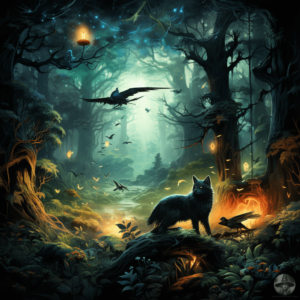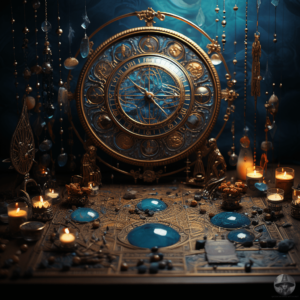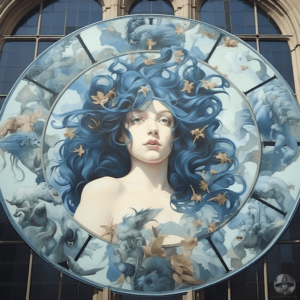 Hello there, magickal friends!
Hello there, magickal friends!
Ever pondered the whimsical world of familiars? From Professor McGonagall's tabby cat to Sabrina Spellman's snarky Salem, the vision of a witch with her quirky animal companion has enchanted us for generations through books and screens. Yet, these fanciful tales have profound roots in real-world folklore and history. So, buckle up and grab your broomsticks as we embark on an enchanting journey into the mystical realm of familiars - the supernatural companions of witches!
For centuries, the concept of familiars - mystical entities or small animals kept by witches - has enthralled the imagination. From the threads of ancient folklore to the tapestry of modern Wicca practices, familiars have been portrayed as magical assistants and spiritual guardians for those who tread the path of the arcane.
The Familiar Foundations: A Trip Down History Lane 

Historically, according to Western demonology, a familiar was perceived as a small animal or imp, bestowed by the devil or inherited from another witch. These creatures, considered low-ranking demons, could assume any form - from common animals like toads, dogs, or black cats to grotesque amalgamations of various species. European folklore from the medieval and early modern periods also suggested that these entities could manifest in human or humanoid forms, appearing as vivid, three-dimensional beings full of color and animation.
Role Reversal: Familiars - Friends or Foes? 


The perception and roles of familiars varied greatly based on their association. In the company of witches, they were often deemed malevolent entities, commonly cast as demons or evil spirits. This association arose from the fears and prejudices of societies that demonized witchcraft and aligned it with the devil.
However, when serving cunning folk - practitioners of folk magick and medicine - familiars took on a more benevolent guise. They were seen as helpful spirits, usually described as fairies or good-natured magickal creatures. This difference in perception largely stems from the roles that witches and cunning folk played in society. Witches were often feared and ostracized, while cunning folk, despite practicing magick, were typically more accepted, as they used their powers for healing and warding off evil spirits.
Despite these stark categorizations, there existed some ambiguity. The line between 'good' and 'evil' was often blurred in the supernatural world, and familiars were no exception. Whether seen as demons or fairies, their primary function was to safeguard and serve their human counterparts, especially as they navigated their magickal practices.
Familiars were often attributed with an array of supernatural abilities to aid their human partners. They could shapeshift, become invisible, spy on others, and even perform tasks on behalf of their human counterparts. Their allegiance was as much a boon as a mark of suspicion, given the superstitious nature of the times.
This dynamic relationship between humans and their familiar spirits provided a complex interplay of fear, respect, and power. Even as the image of familiars has evolved over time, their intrinsic role as spiritual companions in the world of magick has remained consistent.
Familiars Today: The Purr-fect Companion or Hoot of a Helper? 


The idea of familiars has found a place among some contemporary magickal practitioners, notably followers of the Neopagan religion of Wicca. This modern interpretation views familiars as magickal aides, often materializing as pets or wildlife, or even thought to be invisible entities providing assistance.
Today's familiars are a far cry from their historical counterparts. They are no longer viewed as demonic entities or gifts from the devil. Instead, they are seen as part of nature, embodying its spirit, and serving as a conduit between the natural world and the practitioner. This shift reflects a change in perception about witchcraft and magick, which has moved away from the diabolical associations of the past towards a focus on nature and spirituality.
Contemporary witches often view their familiars as integral to their practice, seeing them as spiritual guides, teachers, or companions. They may be called upon during rituals, or help their human partners in divination, healing, and other magickal workings.
It's also important to note that not every pet a witch owns is considered a familiar. The bond between a witch and their familiar goes beyond the usual human-pet relationship. Witches believe that a familiar chooses the practitioner, not the other way around. This bond is said to be psychic, with the familiar and the witch sharing a deep, intuitive connection.
From cats and owls to spiders and snakes, familiars come in all shapes and sizes in the modern age. They continue to serve as an enduring symbol of the magickal connection between humans and the natural world.
Understanding Familiars
Pierre A. Riffard defines a familiar spirit as the double, or alter ego, of an individual. This entity, while it may lead an independent life, remains intimately linked to the person. This spirit companion often takes the form of an animal.
In earlier times, the familiar was believed to feed on a witch's blood, serving as a physical manifestation of the witch's magick and a conduit for their power. This "feeding" ritual was typically performed at certain ceremonies or gatherings, known as witches' sabbaths. Through this ritualistic bond, the witch could command the familiar to carry out her bidding, often in the form of spells or charms.
Moreover, some legends also suggested that witches could send their familiars to do their bidding, such as carrying out hexes or curses against their enemies, gathering information, or even stealing objects. These familiars could travel vast distances in a very short time and had the ability to shape-shift into any creature or object, rendering them virtually undetectable.
As society and culture have evolved, so too has the depiction and understanding of familiars. In contemporary witchcraft, while familiars may not physically consume a witch's blood, they are believed to share in their witch's energy, drawing upon it to enhance their own abilities or powers.
In Wiccan and other Neopagan practices, a familiar is often considered a spiritual entity or energy being that has chosen to align itself with a particular person or witch. This spirit can often guide, protect, and assist the witch in their magickal workings, while also helping them to connect more deeply with the natural world and the energies that permeate it.



Today, the role of the familiar has evolved. Modern Pagans and witches often perceive their pets as familiars. These animals are said to be highly intuitive, sensing their owners' emotions and energy, and sometimes even participating in their rituals.
But familiars aren't always physical. Some practitioners might connect with the spirit of a mythical creature, like a dragon or a phoenix, who embodies certain energies or attributes and appears in dreams, visions, or meditations. These spirit familiars serve as guides, lending their particular strengths to the practitioner's magical workings.
In both cases, whether the familiar is a physical pet or a spirit entity, the bond between a witch and her familiar remains strong, mystical, and deeply personal. The familiar is more than just a helper; they're a companion, a confidant, and a reflection of the witch herself. Whether it's a cat, a dog, a snowy owl, or a fire-breathing dragon, choosing a familiar is a deeply personal process that depends on the witch's individual needs, strengths, and spiritual journey.
In Conclusion
The realm of familiars is as enchanting as it is vast. From the depths of ancient folklore to the heights of contemporary magickal practices, these mysterious beings serve as a testament to the enduring appeal and power of the supernatural.
They've morphed from being feared as demonic entities to being revered as spiritual guides, reflecting shifts in societal attitudes towards magick and witchcraft. In today's world, they stand as a symbol of the deep, spiritual connection between humans and nature.
Though their forms and roles have evolved over time, the essence of familiars - their ability to connect us with the mystical, to guide us on our spiritual journey, and to aid us in our magickal endeavors - remains unaltered. Whether they manifest as a playful kitten, a wise owl, a loyal dog, or even as an elusive spirit, familiars continue to captivate our imagination and beckon us into the realm of the magickal.
So, next time you're curled up with your pet, take a moment to wonder - could they be your familiar? And if you're someone who practices magick, you might already have a mystical companion in your life, ready to aid you on your magickal journey. Who knows what enchanting adventures await you and your familiar in the magickal realm?
Are you ready to dive deeper into the world of witchcraft and familiars? Stay tuned for our next piece, where we'll delve into the intricacies of working with these magickal beings. See you in the mystical realm, fellow seekers of knowledge!












 So, who are Pagans? Pagans are...
So, who are Pagans? Pagans are... 

 Welcome Star Gazers!
Welcome Star Gazers!














 She usually embodies passion, determination, and vibrant energy. However, when reversed, she warns of the potential pitfalls of these same traits when left unchecked. Are there areas in your life where strong determination might be tipping over into demanding or selfish behavior? Or perhaps, are you experiencing jealousy, clouding your ability to appreciate your own journey? Today is an ideal day to reflect on these questions, striving for a healthy balance where ambition doesn't eclipse empathy and kindness.
She usually embodies passion, determination, and vibrant energy. However, when reversed, she warns of the potential pitfalls of these same traits when left unchecked. Are there areas in your life where strong determination might be tipping over into demanding or selfish behavior? Or perhaps, are you experiencing jealousy, clouding your ability to appreciate your own journey? Today is an ideal day to reflect on these questions, striving for a healthy balance where ambition doesn't eclipse empathy and kindness.

 This card suggests the beginning of new, prosperous opportunities in your tangible world, be it career, home, or health. If there's a project or idea you've been pondering on, now might be the time to grasp the opportunity and take that first step. Keep your eyes open today for signs or chances that may lead you towards growth and success.
This card suggests the beginning of new, prosperous opportunities in your tangible world, be it career, home, or health. If there's a project or idea you've been pondering on, now might be the time to grasp the opportunity and take that first step. Keep your eyes open today for signs or chances that may lead you towards growth and success.
